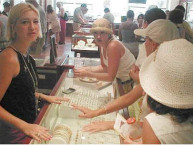Keep Your Fine Jewelry Looking Sparkly
No matter how much money you spend on those fancy packaged jewelry cleaning kits the solution they use is mainly 50% ammonia and 50% water. If you want your own solution to have a fancy color just add a drop of red or blue dye to the solution and you will have the best jewelry cleaning solution for a cost of about 25 cents rather than $5.00.
This solution can be used to clean diamonds, rubies, sapphires, topaz, tourmalines, and just about any non-porous stones, along with any gold jewelry.
DO NOT use this solution with any porous gem material such as pearls, Lapis Lazuli, opal, or any other porous gem that will soak up the solution.
DO NOT allow your local jeweler to put your emerald into a ultrasonic cleaner. As we discussed in a previous section, virtually all emeralds are sealed with a clear resin-like oil and boiling them in an ultrasonic cleaner will take this sealer off.
If you wish to clean pearls, opals, Lapis Lazuli, or other gems of this type use a very mild soap and water solution with a soft cloth. This will remove any dirt without damaging the piece.
Caring for Emeralds. Emeralds should be cleaned with warm water, a very mild
detergent, and a soft brush. Ultrasonic or steam cleaning is not safe and can result in
breakage or inadvertent release of oils (which mask inclusions). Emeralds should be
re-oiled every 2-5 years and reset only by jewelers experienced with the special handling
requirements of these gems. Loose stones should be stored in velvet-lined boxes within
individual compartments. They should be stored separately from diamonds and other harder gems to prevent scratching.
Alexandrite: This gem is sensitive to knocks, it is not resistant to Alkalis. Cleaning methods which are safe are ultrasonic, steamer or warm soapy water. When you are not wearing your alexandrite place it in a clean cloth pouch in a separate compartment from other gems to avoid scratching.
Pearls ; Do not toss your pearls carelessly into your purse,
bag or jewel box. A pearls surface is soft and can be scratched by hard metal edges,
keys etc. The proper way is to place your pearls in a chamois bag or wrap them
in white tissue paper when putting them away. Cosmetics,
perspiration, saliva, perfumes, hairspray and just daily wear and tear can weaken and
stretch the threads on which your pearls are hung. Every year have your
pearls inspected by your jeweler and re-strung if necessary with a knot between each
pearl, preventing a disaster should your pearl string should break. Put
your pearls on after you’ve applied hairspray. Hairspray will cause fine pearls to
yellow.
Opals: Do not use a home ultrasonic machine or jewelry cleaner. Care should be taken to protect it from scratches, sharp blows, household chemicals, and extreme temperature changes ( If you have on an Opal ring in a warm heated car and step out into sub-zero weather the stone may shatter..) To maintain the brilliance of opal, it should be wiped clean with a soft cloth.
Amber: The absolute enemy of amber is oxygen. Before it is unearthed most amber specimens are in an anaerobic environment ( without oxygen). Once they are exposed to air they begin to deteriorate. To care for your amber pieces wash in a mild soap and water and pat dry gently. The acids from skin can be damaging also, it will build up on the piece and begin to break down the surface. Make a habit of regular cleaning of the jewelry.
The simplest measure you can take to protect amber specimens is to keep them in a cool place away from strong light. It’s not too practical to totally exclude oxygen (air) from the amber, but placing it in small sealable plastic bags may help reduce the overall exposure levels over time. For strict archival preservation, consider placing extremely rare or precious material under an inert gas.
Jade: Jade, though quite durable and once used like steel in early tools, is susceptible to breaking and should be handled with care. It is not recommended to clean jade jewelry or figures using gem cleaner. In fact, it is often believe that jade will, over time, continue to darken in color by rubbing it for good luck and you wouldn’t want to wash it all away. We suggest a polishing cloth for cleaning your jade jewelry to maintain its beautiful shine.
Platinum; One of the rarest and most durable of the precious metals, platinum is resistant to tarnishing and discoloration by chemicals. However it still needs to be cared for properly. Store your platinum pieces separately, even the tough platinum can sustain scratches and wear from abrasive edges. If visible scratches do appear, the piece can be easily re-polished by your jeweler.
Silver; Store your silver in a cool, dry place. Preferably in a tarnish preventative bag or wrapped in felt or a soft cloth. Store them individually so they don’t scratch. DO NOT apply those commercial silver cleaners you see advertised on tv. They remove silver and damage your fine jewelry. Use a polishing cloth designed for silver to polish your silver. Tissue paper or paper towels can cause scratches because of the fibers in these products. Prevent tarnish in the first place by not exposing to air and light when stored. Avoid exposure to household chemicals or chlorinated water.
Gold; To clean your gold jewelry at home, you’ll find many commercial cleaners that work well. Pick up a small soft chamois to keep it nice and shiny. Remove al gold jewelry before showering, cleaning, swimming in chlorinated pools or hot-tubs. The chlorine and harsh chemicals will leave your fine gold pitted and weakened over time. If you find an old piece of gold that is covered with tarnish, make a solution of soap and water mixed with a few drops of ammonia. Place the jewelry in the solution and softly brush the piece with a
soft toothbrush. After brushing, rinse the solution off with lukewarm water and pat dry with a clean cloth. If your gold jewelry contains colored gemstones, look up the care of that gemstone before cleaning.
Diamonds: Diamonds attract skin oils. If a human touches a diamond the oils adhere to the surface. Use the cleaner mentioned above periodically. Avoid household cleaners and chlorine bleach. Chlorine in pools and hot-tubs will damage your gold setting, pitting the gold and may weaken prongs over time, leaving a danger of loosing your diamond. Do not
wear your diamond jewelry, especially rings, when doing rough work. A diamond is tough but can be chipped or damaged by a sharp blow. When they are stored in your Jewel box keep them separated from other jewelry, if they slide up against another piece they will scratch the other piece.
Watches; Have your watch inspected on a yearly basis by a watchmaker or authorized dealer and serviced according to the manufactures guidelines. Replace scratched or broken crystals immediately. Even the smallest of cracks can allow moisture into your watch and damage it. If your watch is a wind-up, wind it in a clock-wise direction, preferable at the same time each day. Remove the watch from your wrist when winding to reduce the pressure on the stem of the watch. If your watch is not a wind-up, the automatic movement engine is built for continuous operation – running 24 hours a day. To ensure peak performance, owners are advised to have their mechanical watches checked and serviced every two years. Oils from your skin will build up on your
watch.
If your watch is water resistant you can clean your watch with a mixture of warm water and mild soap. Pat the watch dry after cleaning. If the strap is leather clean only the metal watch, not the strap with this mixture.. If your watch is not water resistant clean the watch with a slightly damp cloth and then pat dry. Have your batteries checked
during the yearly inspection. Dead batteries left in the watch can leak or corrode, ruining the watch. When your jeweler places a fresh battery in your water-proof watch be sure to confirm that they have tested the seal on the case, that it is still water-proof. Avoid violent shocks, falls, and repeated abrasions that can scratch metal or harm the mechanism of the watch. Also avoid chemical products, high temperatures, and strong magnetic fields to keep your watch in full working order.
A Guide to cleaning your gems
| Gemstone | Toughness | Steam | Ultrasonic |
| Alexandrite | excellent | yes | yes |
| Amber | poor | no | no |
| Amethyst | good | no | no |
| Aquamarine | fair | no | no |
| Citrine | good | no | no |
| Coral | fair | no | no |
| Diamond | good | yes | yes |
| Emerald | poor | no | no |
| Garnet | good | no | no |
| Iolite | poor | no | no |
| Lapis Lazuli | fair | no | no |
| Opal | poor | no | no |
| Pearl | poor | no | no |
| Peridot | poor | no | no |
| Ruby | excellent | yes | yes |
| Sapphire | excellent | yes | yes |
| Spinel | good | yes | yes |
| Tanzanite | poor | no | no |
| Topaz | poor | no | no |
| Tourmaline | good | no | no |
| Turquoise | good | no | no |
| Zircon | fair | yes | yes |
Jewelry care sounds very scary doesn’t it???
Not really. Just explain to your significant other that now that you are the wearer of fine jewelry and gems you can no longer be exposed to household chemicals, harsh chlorine bleach, or rough manual labor. No problem.



